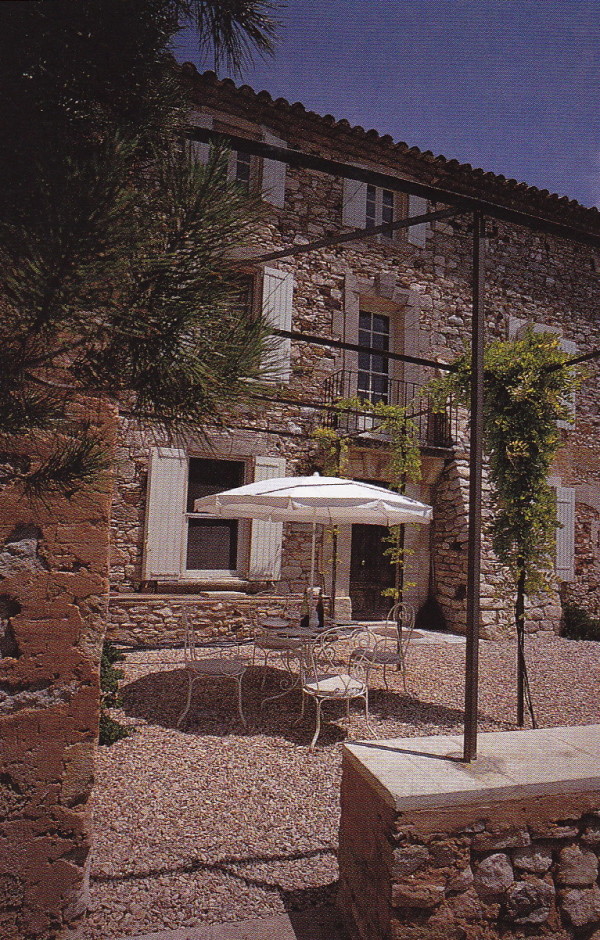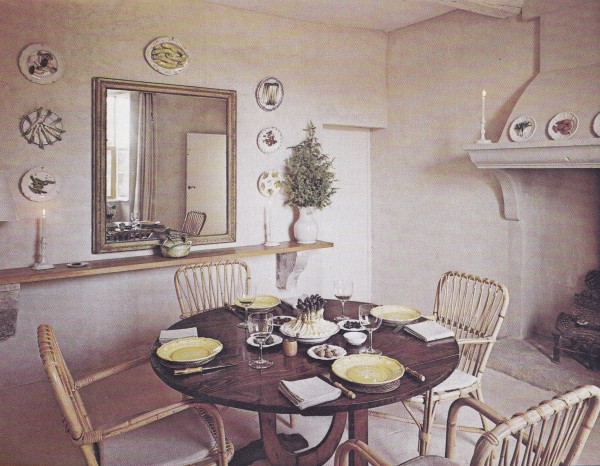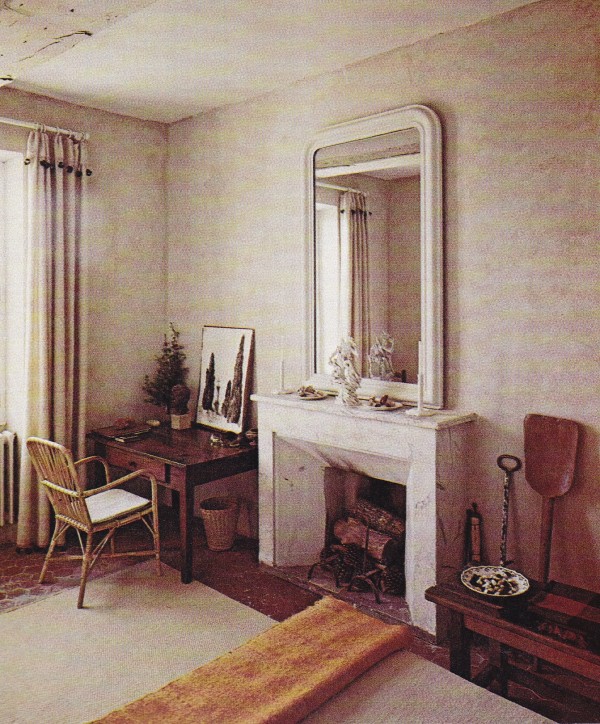Van Day Truex – once dean of The Parsons School of Design and design director of Tiffany & Co., and friend of Billy Baldwin and teacher to Albert Hadley – epitomized restraint and elegance. Truex is famous for his design directive: “Control, edit and distill”. A distillation of his thoroughly edited approach to classicism was tested further in the simply elegant rooms he created for himself in Provence in the 1960’s and 1970’s. Of the Lubéron valley Truex wrote for Architectural Digest in 1975 “The countryside is strong and lovely, with a bracing climate of sun and wind. A mixture of dramatic elements of nature and a careful cultivation, the land is rich with ancient history.”
Van Day Truex’s first of three houses was in the ancient town of Gordes, which he purchased in 1962. The Louis XIII-period house afforded Truex his every whim – grand proportions, spacious private rooms, every architectural detail he’d ever dreamed of. Unfortunately, the house turned out to be a tremendous financial burden. Soon after he purchased the property structural reinforcements were required on the rear terrace to prevent the structure from sliding down a hill. He went through with the repairs but in the end it proved too much to maintain. As much as he loved the house he decided a more modest dwelling would be better suited to his lifestyle. In the second photo below few and simple furnishings contribute to a monastic sparseness.

The entrance to Truex’s Louis-XIII period residence in Gordes, Provence. Photo courtesy of Van Day Truex: The Man Who Defined Twentieth-Century Taste and Style.

The grand salon in Truex’s house in Gordes. Photo courtesy of Van Day Truex: The Man Who Defined Twentieth-Century Taste and Style.
In 1964 Truex purchased an abandoned farmhouse that he would name Chaumet – “thatched cottage” – on twenty acres of land outside the town of Gargas. He made the necessary adaptations while ensuring that the house was in keeping with its surroundings. It embodied the rustic simplicity of an 18th-century farmhouse of this region while incorporating his preference for unadorned stone and unglazed terra cotta tiles for the floors, and the simplest of decoration – cotton and linen textiles, simple furnishings of natural materials, and a neutral color palette of beige. Truex maintained “In design, Mother Nature is our best teacher.” Did I mention before that nature is my muse? It’s no wonder I resonate with his work.
In his living room at Chaumet Truex used the simplest fabrics, rattan seating, French provincial tables and a pair of converted aubergine color wine jugs as lamps. On and around the fireplace natural objects and an African mask were introduced as art to great affect, a tableaux as much in use today.
Van Day Truex used a simple over-scale mirror with a white frame in a modern way over the sofa in a seating arrangement opposite the fireplace, furthering the room’s airy and light spareness. The bold and simple markings of the modern art work on the far right compliments the primitive nature of the mounted horns as art.
The only decorative accessories used are a collection of trompe l’loeil faience plates hanging on the dining room walls, from the collection Truex had designed for Tiffany’s. And the only interjection of color, other than the aubergine lamps in the living room, is a set of saffron color plates made from pigments from a nearby village. For all its simplicity it is elegant and classically proportioned.
Simplicity continues into Truex’s monastic bedroom. Without knowing otherwise it would be difficult to date this room, with its simple lines, natural materials, and casually placed art work leaning against the wall on the desk. It far better suits me than many of today’s overly decorated, self-conscious rooms filled to the brim with the latest fads and trends.

Chaumet, Gargas, Provence. Photo courtesy of Van Day Truex: The Man Who Defined Twentieth-Century Taste and Style.

The dining terrace at Chaumet outside Gargas, Provence. Photo courtesy of Van Day Truex: The Man Who Defined Twentieth-Century Taste and Style
Though Truex succeeded in his quest for elegant simplicity, in the end, it wasn’t what he truly wanted. Of Chaumet he said “The whole experience was far too much work. The house was so isolated that no one wanted to come for dinner for fear of getting lost. It was hell.” He stayed five years until loneliness overcame him. In spite of his frustration with feeling isolated Chaumet was a great success: it was featured in L’OEil magazine, in European Decoration: Creative Contemporary Interiors, and the New York Times Magazine (1979) – just before he sold the property – which made note of Truex’s passion for natural materials in decorating and his use of straw, cotton, animal prints, and, above all, the color beige. “Remember, color is not color but mood, temperature and structure” advised Truex.
With his new wealth of knowledge pertaining to the restoration of houses he became energized to build one of his own design. He chose the village of Ménerbes, known for its ancient picturesque beauty. It is, personally, one of my favorite Provençal villages, made popular years ago by Peter Mayle who wrote about his experiences living there in A Year in Provence, and subsequent titles. Much of the hype surrounding his novels has since died down. While visiting there in May the weather was wonderfully pleasant and the village comfortably occupied. Its unique and quiet beauty and vast vistas beholds endless charm.

Photography by Horst for House & Garden (From Van Day Truex: The Man Who Defined Twentieth-Century Taste and Style).
Truex’s pièce de résistance was the realization of a decades old dream of one day having a nautilus-design stairway like the one Le Corbusier designed for Charles de Beistegui’s Paris apartment in 1930.

The “movie room” in Charles de Beistegui’s apartment on the Champs-Élysées, Paris; reproduced from Architectural Review, April, 1936 (courtesy of Twentieth-Century Decoration by Stephen Calloway).
Van Day’s Truex’s realization of a nautilus-inspired staircase is far more elegant than Le Corbusier’s tightly wound corkscrew, although for its time it was considered quite elegant and à la mode. There is no staircase more beautiful than this – Truex’s – so elegantly carved from plaster into a sinuous S-curve, at one with its connecting walls, floor and ceiling, as if carved from one piece of stone.

Photography by Horst for House & Garden (from Van Day Truex: The Man Who Defined Twentieth-Century Taste and Style).
All exterior and interior walls were finished in the same texture and color: beige. All door and window lintels were cut from native stone. The floors were laid with natural, unglazed terra cotta tiles made locally. Teak wood was used for interior and exterior trim, left to age and weather naturally without paint or varnish. Where curtains were used only the simplest cotton was hung. Much of the furniture came from his previous residences – rattan and wooden furniture made locally.
Of his visit to Truex’s new residence in Ménerbes Hubert de Givenchy reflected “I admired everything that Van had done. The house was, first of all, an honest house. Extremely modest, it had a monastic quality. The bare-bone details embodied style and sophistication. It was so remarkably pure that it made me want to go home and eliminate the unnecessary things from my own house. If I had to think of one word to describe Van’s taste I would say it was cashmere. The finest and rarest cashmere. Being in the fashion business, I offer this as my highest praise.”

Rory Cameron, left, with Truex in Ireland. Photo from Van Day Truex’s personal collection, courtesy Van Day Truex: The Man Who Defined Twentieth-Century Taste and Style.
Truex’s only close friend in the Lubéron was Rory Cameron. They met in the 1950’s while Cameron was living with his mother, Lady Kenmare, at her villa, La Fiorentina, at Saint-Jean-Cap-Ferrat. They remained close with a shared enthusiasm for the decorative arts. Cameron went on to live in Ireland for a short stint before being lured to the Lubéron by Truex in the early 1970’s. Truex’s collaborative design for Cameron’s Provencal mas, Les Quatre Sources, would become much photographed and talked about in the years ahead. Les Quatre Sources would also feature a nautilus-inspired stairway which Truex so greatly admired. Remarking on her visits to both Truex’s and Cameron’s homes Mrs. William McCormick Blair, Washington’s arbiter of good taste at the time, commented “I will always remember Van [as] having the most rare and beautiful imagination of any man I ever met. His impact on the decorative arts was not ever, in any way or sense, wild or extravagant but always restrained, disciplined, and transforming.” I can’t think of a more suitable or desired compliment.

Les Quatre Sources, Rory Cameron’s residence in Provence. Van Day Truex collaborated with Cameron on the nautilus-style stairway.
Van Day Truex expertly distilled the essence of the Lubéron in his country homes utilizing a natural palette, natural materials and fibers, textured wall finishes, simple furnishings of hand-made quality, and simple decorative objects, all contributing to the rustic simplicity of the region without ever appearing contrived. These rooms are as fresh and relevant today as when Truex conceived of them as early as the 1960’s. It is testimony to his claim, “good design is forever”.
In my previous post, Toujour Provence, I mentioned visiting the Provençal homes of Jacques Grange and François Catroux in the coming posts after this one; however – though we will most definitely take these tours – it seems only natural to first visit the home of Rory Cameron, Van Day Truex’s close friend, beforehand. Besides, it’s nice to keep things a bit loose and organic, don’t you think? Au revoir until then. See you chez Cameron!





















What a great and beautiful post…as always I have learned knowledge… about design… as well as personal stories about another designer… thank you!
Victoria
Thank you, Victoria! I appreciate your comments and taking the time to read my posts. I love writing them but they do sometimes take a bit of time to pull together. In our age of instant gratification and image overload I think it’s important to tell the back-story on these great designers. Very little has been published on Van Day Truex yet he inspired so many great talents, many of whom we have honored with elaborate monographs. As always, your comments are greatly appreciated!
Cristopher